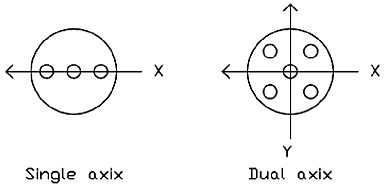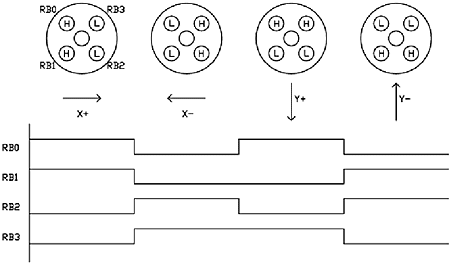技術資料 »
Electrolytic Tilt Sensor Signal Conditioning
Principles of Operation
|
|
 |

Download this document as a PDF file |
|
This is a description into the operation of an electrolytic tilt sensor to obtain an electrical output relative to tilt angle. The flowchart below (Figure 1) is an outline of the basic building block to achieve this result. This flowchart is a representation of the schematic titled “Wide angle single axis signal conditioner”.

Figure 1
Let’s start with the micro-controller to define the sensors excitation. Two output ports are used to drive the sensor's outer pins. These ports are toggled at a 50 percent duty cycle for a recommended period of around 400 hertz. Assuming that the software to toggle these ports is precisely timed to prevent any deviation from a 50 percent duty cycle there should be a minimum of non-symmetry. Non-symmetry can be defined as direct current to the sensor. Direct current to the sensor can result in poor performance such as drift.
Now that the sensor has an excitation signal, let’s examine the sensor's output. This signal is a ratio of the excitation signal determined by the tilt of the sensor. At the null or balanced position the output will be a flat line near the midpoint of the input signal. As the sensor is tilted in either direction, the input waveform will appear with the amplitude increasing with an increasing tilt angle of the sensor. The phase of this waveform will depend on which direction the sensor is tilted. This will indicate positive or negative angles. The signal then goes to a CMOS buffer to prevent any load on the output pin. The output of the buffer is connected to the input of the analog to digital converter in the micro-controller.
The micro-controller has the job of processing the signal from the sensor. Since it knows the timing for the excitation to the sensor, it needs to take voltage level samples from the sensor. This is done during each half cycle. Multiple samples during each half cycle are recommended since these can result in a higher bit count and can also be averaged for a more accurate result. One half cycle is subtracted from the other half cycle and the result will be an indication of the tilt angle. The sign of the result will indicate which direction from null that the sensor is tilted.
The micro-controller now has a value that is a representation of the tilt angle. This value can be internally processed or sent directly to another external component. As mentioned above, the critical factors are the signals to and from the sensor. Depending on the choice of micro-controllers, consideration needs to be given to have equal and adequate source and sink drive current to the output ports. If the micro-controller loses power or is turned off in successively short intervals, it may become necessary to incorporate a shut down routine to ensure that a full cycle is delivered to the sensor thus preventing non-symmetry or direct current.
Now that we reviewed the basic input and output requirements of the tilt sensor, lets move on to a combination single/dual axis tilt sensor signal conditioner. Refer to the schematic titled “Universal single dual axis signal conditioner (Figure 2)” for the remainder of this article. This circuit will provide signal conditioning for either a single or dual axis tilt sensor. This circuit is also available as a complete assembly including the tilt sensor from The Fredericks Company.
Let’s start by examining the sensor position for each axis. In the single axis mode of operation, the tilt sensor is mounted with the pins in line with the sensitive axis. In the dual axis mode of operation, the tilt sensor is mounted in a 45-degree rotation from the single axis mode. This is shown in the Figure 2 below.

Figure 2
Excitation for the dual axis requires that a dual set of pins be excited for each half cycle and each axis. This would result in a four-quadrant waveform. Shown in Figure 3 is the polarity on each pin for each quadrant of excitation. The output ports of the micro-controller provide excitation. The excitation signals must be timed in software in order to provide a symmetrical waveform. This is to prevent any dc component to the tilt sensor.
Note: Single axis sensors are connected to pins 1 and 3, which correspond to ports rb0 and rb2 respectively. These are not rotated 45 degrees from their original axis. The output is processed the same as the dual axis and derived from the x axis.

Figure 3
Now that we have excitation to the tilt sensor, we can condition and process the signal from the output (center) pin of the sensor. The output pin is connected to a high impedance buffer to provide isolation. The signal is then filtered and amplified. The signal is split into two amplifiers for the X and Y signals. This is done in order to independently adjust the gain and offset for each axis. The amplifiers are provided with an AC offset adjustment from the excitation signals. This is accomplished through resistors to the null trim potentiometers. The signal is then delivered to the input of the analog to digital converter in the micro-controller.
Let’s assume the tilt sensor is tilted in the positive direction for the X and Y axis. X is one-third of the tilt range and Y is two-thirds of the tilt range. Shown in Figure 4 is the input waveform to the a/d converter for each axis.

Figure 4
Note: If the tilt sensor was tilted at the same angle but in the negative (opposite) direction for both axis, the waveform shown in Figure 4 would be in the opposite phase. Also, at the null position for any axis, there would be no difference between the positive and negative quadrant voltage. For example, it would be a flat line around 2.5 volts.
At this point, the analog to digital converter can take samples at each half cycle for the X and Y axis. The analog to digital converter samples are synchronized with the excitation drive to the tilt sensor to read the voltage during each quadrant. Multiple samples may be taken during each quadrant and averaged to produce greater resolution. The tilt angle from the null position can be derived by the difference between the X+ and X- voltage for the X axis. This also applies to the Y axis. The amplitude of the resulting voltage represents an amount of tilt from the null position.
For example:
X axis tilt = (X+) – (X-)
Y axis tilt = (Y+) – (Y-)
Now that we have values for the X and Y axis, we can utilize the micro-controller to output this data in various forms. In the reference schematic, the output is delivered in two forms. One is in the form of a pulse width modulated output for each axis. The other is output in serial form to a digital to analog converter. There the output is delivered to two amplifiers for gain and offset adjustment for each axis.
The primary software flow to excite and read the tilt sensor and output the sensor data is as follows,
- Start an interrupt to toggle the output ports for the tilt sensor excitation. This would produce the 4-quadrant pattern as shown in Figure 3.
- Read the tilt sensor output for each of the 4-quadrants. This would be timed with the occurrence of the interrupt.
- Process and output the data during the next multiple of 4-quadrant interrupts.
- Return to step 2.
Note: There can be other variation in the above sequence as long as the interrupt toggles the output ports for the tilt sensor excitation at a fixed timing rate. Each quadrant should have the same period. In this described circuit the period for each quadrant is approximately 2 msec.
